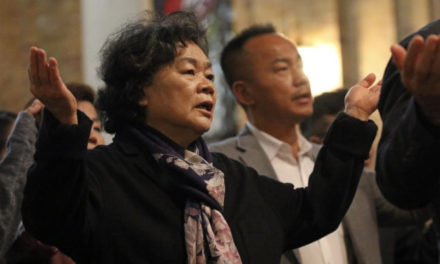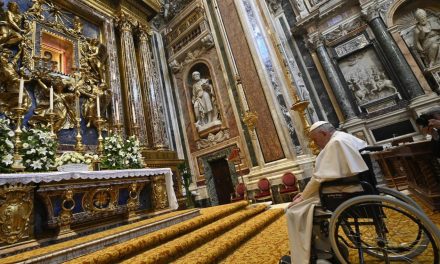
Pope: ‘La Guadalupana’ shows that everyone has a place in the Church


Pope Francis incenses an image of Our Lady of Guadalupe while saying Mass for the feast in St. Peter’s Basilica, Dec. 21, 2017. DANIEL IBAÑEZ/CNA
VATICAN— Pope Francis marked the feast of Our Lady of Guadalupe Tuesday saying the “mestizo” Virgin is a concrete sign that the Church is for everyone, especially the poor and marginalized.
Noting how Juan Diego, when Mary first appeared to him, had said that he was no one and wasn’t worthy, the Pope said this sentiment can often be felt today in Latin America’s indigenous and Afro-American communities, “which, in many cases, are not treated with dignity and equality of conditions.”
This feeling of shame and unworthiness, he said, is also shared by many women “who are excluded because of their gender, race or socioeconomic situation,” and by youth who “receive a low-quality education and don’t have opportunities to progress in their studies nor enter the field of work in order to develop themselves and build a family.”
It is also the feeling of the many poor, unemployed, migrants, and displaced people “who try to survive in the informal economy,” and is also the shame felt by young boys and girls who are subjected to child prostitution, which Francis noted is “often linked to sexual tourism.”
However, Mary, the Mother of God, is the image of the Church, he said, and from her we learn how to be a Church “with a ‘mestizo’ face, with an indigenous, African-American face, the face of a peasant,” just like Our Lady of Guadalupe, he said.
In her, we see the face of the poor, the unemployed, of the young, and the old, “so that nobody feels sterile or infertile, so that no one feels ashamed or that they are nothing.”
Pope Francis celebrated Mass in St. Peter’s Basilica marking the Dec. 12 feast of Our Lady of Guadalupe.
Veneration of Our Lady of Guadalupe dates back to the 16th century when a “Lady from Heaven” who identified herself as the Mother of the True God appeared to Saint Juan Diego, a poor Indian from Tepeyac, on a hill northwest of Mexico City.
She instructed Juan Diego to have the bishop build a church on the site of the apparitions. As a sign, the now-famous image of Our Lady of Guadalupe was imprinted miraculously on his tilma, or cloak. Both the image and the tilma remain intact after more than 470 years.
Pope Francis centered his homily for the celebration around the Gospel reading from Luke, in which Mary visits her cousin Elizabeth shortly after the Annunciation.
The Pope noted how when Mary arrives, one of the first thing Elizabeth says is “how does this happen to me, that the mother of my Lord should come to me?”
Elizabeth, who had previously been marked by the sign of sterility, is now singing praise “under the sign of fertility and amazement,” Francis said.
He pointed to the two states of Elizabeth before and after her encounter with Mary: first her sterility and then her fertility and amazement.
The religious mentality at the time viewed sterility “as a divine punishment” for a personal sin or the sine of one’s spouse, he said, noting that it was “a sign of shame she carried in her own flesh because she considers herself guilty of a sin that she did not commit or because she felt like nothing since she was not able to live up to what was expected of her.”
This type of sterility, the Pope said, is one “that goes deep and ends up paralyzing all life,” and which takes on “the many names and forms of every time a person feels in their flesh the shame of being stigmatized or feeling like nothing,” much like Juan Diego.
However, after meeting Mary, Elizabeth becomes fertile and filled with wonder, he said. She is the first one to recognize her cousin as the Mother of God, and she also experiences in her own flesh the fulfillment of God’s word, because she now carries the “precursor to salvation.”
In Elizabeth, Francis said, we understand that “God’s dream is neither sterility nor to stigmatize or shame his children,” but is rather “to bring forth in them and from them a song of blessing.”
The same goes for Juan Diego, he said, noting that it was precisely he, and no one else, that carried the image of the Virgin in his tilma: “the Virgin of brown skin and a ‘mestizo’ face,” he said, referring to the fact that she was of a mixed indigenous race. The term “mestizo” was used at the time to describe the children born to Spanish and Aztec parents.
By appearing this way, Our Lady, he said, is a mother who is capable of taking on the various traits of her children “in order to make them feel part of her blessing.”
In thinking about the themes of sterility and fertility or fruitfulness, Francis said we can also relate these to the richness of the cultural diversity in Latin American and the Caribbean.
This diversity, he said, is “a sign of the great richness that we are invited not only to cultivate, but, especially in our time, to courageously defend from all attempts to homogenize which end up imposing – under attractive slogans – a singular way of thinking, of being, of feeling, of living.”
In the end, these efforts at uniformity end up “making either invalid or sterile everything inherited from our elders.” They make people, and especially the youth, “feel like nothing because they belong to this or that culture.”
Pope Francis said the diversity and fruitfulness of Latin America makes it a requirement “to defend our peoples from an ideological colonization” which seeks to cancel out what makes these cultures rich and unique, “be they indigenous, African-American, mestizo, peasants or suburban.”
On the contrary, everyone is called to be like Elizabeth and Juan Diego, feeling that they are “the bearer of a promise, of a hope,” but as one people, without canceling out the features of one or another.
The Pope closed his homily encouraging faithful to echo the song of Elizabeth, and, like so many who never tire of repeating it, say together: “blessed are you among women, and blessed is the fruit of your womb, Jesus.” CATHOLIC NEWS AGENCY









